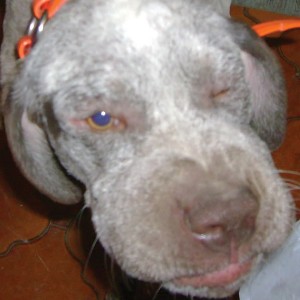All dogs are curious and just love to run and chase things…so I bet I’m not alone when I see my own dogs chasing a bee in the garden and run out in a panic!


Most of the time bee and wasp stings only cause minor pain and irritation. Dogs are most frequently stung on their faces after investigating an insect too closely, but a sting on your dog’s nose is particularly painful. Some dogs may even get stung on the tongue or inside their mouth or throat if they try to bite or catch an insect. These can cause swelling which can close your dog’s throat and block its airway.
Which sting?
- A bee’s sting is barbed and designed to lodge in the skin, killing the bee when it detaches from the body and leaving the sting behind.
- Wasp stings are not barbed but are more painful, and if provoked these insects can sting multiple times.
Dealing with multiple stings
- If you see your dog disturb a hive or swarm of wasps or bees, call the dog to you and run or pick up your dog and carry it away.
- Try to put distance between your dog and the swarm as fast as you can.
- Once you and the dog are safe, get medical attention as soon as possible if he (or you!) has been stung.
Allergic reaction
Some dogs have an allergic reaction to the chemicals in the sting.
- Signs of a severe reaction include general weakness, difficulty breathing, and a large amount of swelling extending away from the sting site.
- Watch out for swelling around the neck, throat and head.
If your dog is having a severe reaction, you should quickly take him to a vet. - Give antihistamines to your dog right away (your veterinarian can give you a supply for your dog’s first aid kit, and advise you on dosage and administration).
Treating stings – Just remember B and V
B: Bicarb for Bee Stings (neutralises the acid based venom)
- If the sting is still present, try to remove it by scraping with a fingernail or a rigid piece of card.
- Avoid using tweezers or forceps to remove it unless absolutely necessary because this may squeeze more venom out of the sting. Remember, the bee sting is barbed – designed not to come out easily!
- Apply a weak mixture of water and baking soda to the affected area as this will help reduce the pain.
V: Vinegar for Vasp Stings (neutralises the alkaline based venom)
- Apply a compress of vinegar to the sting area to help reduce the pain.
Swelling
- You can also wrap ice or an icepack in a towel and apply to the area to reduce swelling and ease any pain.
- Keep an eye on your dog after he’s been stung to make sure he doesn’t develop an allergic reaction.
- If, after several days, the swelling still persists, call your vet.

